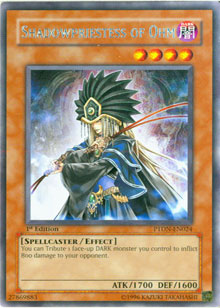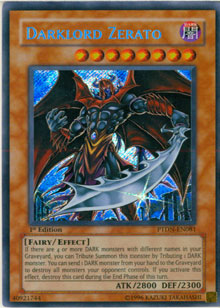This week, we look at flip summons and what happens when we retain priority after summoning a monster.
What Is a Flip Summon?
Flip summoning a monster has some similarities to normal summons. When a monster is flip summoned, both players are allowed to activate effects that will negate the flip summon before the monster’s effects are applied. When a player flip summons a monster with a flip effect, like Magnetic Mosquito, the flip effect doesn’t start a chain until the flip summon is considered to be successful. If you negate the flip summon of Magnetic Mosquito using Solemn Judgment, its flip effect will not activate because its flip summon is not successful.
The continuous effects or trigger effects of the flip-summoned monster will not be applied until its flip summon is successful. When I flip summon a Jinzo that was forced into face-down defense position by Book of Moon, my opponent can still negate the flip summon with Horn of Heaven because Jinzo’s continuous effect won’t be applied until its flip summon is successful. It doesn’t matter that Jinzo was already face up on the field before he was flipped face down.
The application of trigger effects and flip effects follows the rules established with normal summons. Flip summons work like trigger effects, but they fall into a special category all their own because they’ve been designated with the term "Flip:" in their card text. Some monsters have trigger effects that activate when they are flip summoned, like Nightmare Penguin, and these effects should not be confused with flip effects. Just remember that an effect is only a flip effect if it starts with the "Flip:" phrase. The flip effect of the monster will be chained with any trigger effects that activate when the monster is flip summoned.
Example: Chose the Wrong Guy
 Player A has Magnetic Mosquito set. Player B has Cloak and Dagger face up in his spell and trap card zone, naming Magnetic Mosquito. He also has Cyber Dragon and Cyber Valley in face-up attack position. Player A flip summons Magnetic Mosquito, activating its flip effect.
Player A has Magnetic Mosquito set. Player B has Cloak and Dagger face up in his spell and trap card zone, naming Magnetic Mosquito. He also has Cyber Dragon and Cyber Valley in face-up attack position. Player A flip summons Magnetic Mosquito, activating its flip effect.
Player B’s Cloak and Dagger sees Magnetic Mosquito and activates its effect. Both effects are placed onto the chain, with Magnetic Mosquito first on the chain, followed by Cloak and Dagger. Cloak and Dagger resolves first and removes Magnetic Mosquito from play, but Magnetic Mosquito’s effect is still resolved, and it destroys Cyber Dragon and Cyber Valley.
Example: Exxod Vs. Great Spirit
Player A has Exxod, Master of the Guard in face-up defense position and Great Spirit in face-down defense position. She begins her main phase 1 by flip summoning Great Spirit and says that she will activate its effect.
Both Exxod, Master of the Guard and Great Spirit have trigger effects that activate at this time. Exxod’s effect is mandatory and Great Spirit’s is optional, so Exxod’s effect is placed first on the chain, followed by Great Spirit.
Priority Is Retained
When priority is brought up in a discussion, it usually involves the summon of monsters and effects players want to activate after summoning their monster. Priority doesn’t mean a person gets to do whatever he or she wants and the opponent can’t do anything about it. Priority gives us an idea of what actions a player is allowed to take, and it is usually an issue of turn player versus non-turn player. The turn player is the player who is conducting his or her turn, and the non-turn player is the opponent.
When the turn player retains priority, he or she tends to retain it to activate the ignition effect of one of that player’s monsters. When the turn player normal summons or flip summons a monster, he or she is allowed to retain priority to activate the ignition effect of a monster that player controls. This option doesn’t exist until the monster’s summon is successful. If the monster’s summon is negated, you don’t get the chance to activate its ignition effect, just like you wouldn’t apply its continuous effects or activate its trigger effects.
When the monster’s normal summon or flip summon is successful, the turn player can declare his or her intention to retain priority and activate the ignition effect of one of that player’s monsters. It doesn’t have to be the ignition effect of the monster that player summoned. If that player has a monster with an ignition effect on his or her side of the field and the monster that player normal summons does not have an ignition effect, the duelist could retain priority to activate the ignition effect of the monster that player already has control of.
Example: Doriado’s Naughty Sister?
 Player A has Shadowpriestess of Ohm in face-up attack position. Player B has Bottomless Trap Hole set in his spell and trap card zone. Player A normal summons Gil Garth.
Player A has Shadowpriestess of Ohm in face-up attack position. Player B has Bottomless Trap Hole set in his spell and trap card zone. Player A normal summons Gil Garth.
She can retain priority to activate the ignition effect of Shadowpriestess of Ohm and tribute Gil Garth, before Player B can destroy it with Bottomless Trap Hole.
Retaining priority to activate the ignition effect of a monster doesn’t mean that you immediately get your effect. It only means that you are able to put your monster’s effect onto the chain. Your opponent is still allowed to activate effects in response, including effects that respond to the summon. The turn player’s effect that he or she retained priority to activate would be placed first onto the chain, followed by the opponent’s response, if any. Since chains resolve last-to-first, the opponent’s card effect will resolve first.
Example: Exiled Vs. the Unexpected
 Player A has three Sheep Tokens in defense position on her side of the field. She begins her main phase 1 by normal summoning Exiled Force. She declares that she retains priority to activate its effect, tributing it and targeting Player B’s Darklord Zerato. Player B activates Torrential Tribute. Player A does not respond, so Player B continues the chain with Interdimensional Matter Transporter, selecting Darklord Zerato.
Player A has three Sheep Tokens in defense position on her side of the field. She begins her main phase 1 by normal summoning Exiled Force. She declares that she retains priority to activate its effect, tributing it and targeting Player B’s Darklord Zerato. Player B activates Torrential Tribute. Player A does not respond, so Player B continues the chain with Interdimensional Matter Transporter, selecting Darklord Zerato.
When the chain resolves,
Darklord Zerato is removed from play and then
Torrential Tribute destroys the Sheep Tokens remaining on the field.
Exiled Force’s effect disappears, because
Darklord Zerato is no longer on the field.
Retaining priority to activate an ignition effect is not possible if a trigger effect activates when the monster is summoned. In this case the trigger effect automatically starts a chain, and it isn’t possible to chain the ignition effect of the summoned monster. You would be trying to chain a spell speed 1 effect to another spell speed 1 effect, and that isn’t possible.
Example: King Tiger Wanghu Ruling
Player B has King Tiger Wanghu face up on his side of the field. Player A normal summons Exiled Force. King Tiger Wanghu’s trigger effect automatically activates because Player A has normal summoned a monster with less than 1400 ATK.
Player A cannot retain priority to activate the effect of her Exiled Force because she cannot chain its effect to another spell speed 1 effect, King Tiger Wanghu.
Next week we will compare "inherent" special summons with special summons that use the chain. Until then, send all comments and questions to Curtis(at)Metagame(dot)com.
—Curtis Schultz